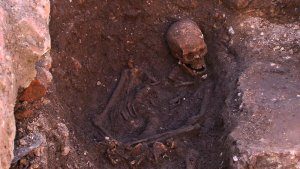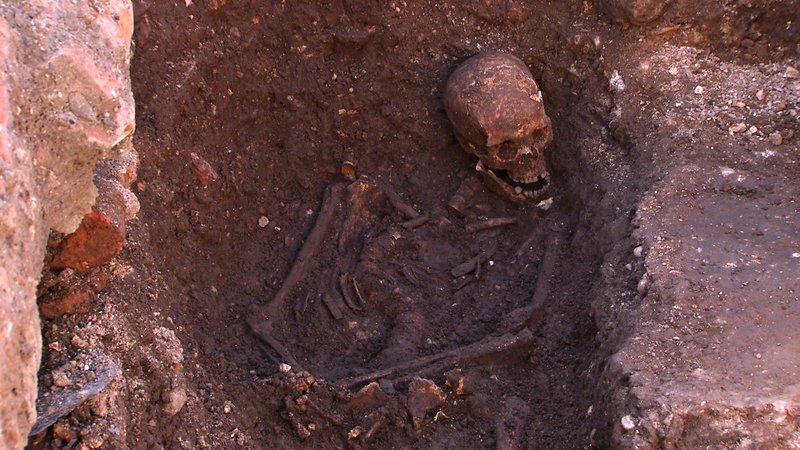
The international research team led by Dr Turi King from the University of Leicester Department of Genetics has now provided overwhelming evidence that the skeleton discovered under a car park in Leicester indeed represents the remains of King Richard III, thereby closing what is probably the oldest forensic case solved to date.
The team of researchers, including Professor of English Local History, Kevin Schürer, who is also Pro-Vice-Chancellor for Research at the University of Leicester and led the genealogical research for the project, has published the findings online today (Tuesday 2 December) in the peer-reviewed journal Nature Communications.
The researchers collected DNA and analysed several genetic markers, including the complete mitochondrial genomes, inherited through the maternal line, and Y-chromosomal markers, inherited through the paternal line, from both the skeletal remains and living relatives. The study is also the first to carry out a statistical analysis of all the evidence together, to prove beyond reasonable doubt that Skeleton 1 from the Greyfriars site in Leicester is indeed the remains of King Richard III.
____________________________________
 The excavated remains of Richard III, discovered at Greyfriars. Courtesy University of Leicester
The excavated remains of Richard III, discovered at Greyfriars. Courtesy University of Leicester
___________________________________
Their results: While the Y-chromosomal markers differ, the mitochondrial genome shows a genetic match between the skeleton and the maternal line relatives. The former result is not unsurprising as the chances for a false-paternity event is fairly high after so many generations. They have also shown beyond reasonable doubt that Skeleton 1 from the Greyfriars site in Leicester is indeed the remains of King Richard III. Genetic markers related to the King’s hair and eye colour indicated that he probably had blond hair and blue eyes, appearing most similar to his depiction in one of the earliest portraits of him that survived, the one curated by the Society of Antiquaries in London.
“The combination of evidence confirms the remains as those of Richard III,” said Shürer. “Especially important is the triangulation of the maternal line descendants.”
Says King of the report: “Our paper covers all the genetic and genealogical analysis involved in the identification of the remains of Skeleton 1 from the Greyfriars site in Leicester and is the first to draw together all the strands of evidence to come to a conclusion about the identity of those remains. Even with our highly conservative analysis, the evidence is overwhelming that these are indeed the remains of King Richard III, thereby closing an over 500 year old missing person’s case.”
Simon Chaplin, Director of Culture & Society at the Wellcome Trust, added: “It is exciting to have access to genetic data from any known historical individual, let alone a king of England lost for more than 500 years, so we are thrilled to be able to support this fascinating project through our Research Resources grant scheme. Adding this information to a wealth of existing material about Richard III further highlights the ways in which studying human remains can inform our understanding of the past, and we look forward to learning more about Richard for many years to come.”
The research team now plans to sequence the complete genome of RIII to learn more about the last English king to die in battle.
See the videos detailing the research and findings below.
___________________________________
___________________________________
___________________________________
The University of Leicester was the principal funder of the research. Dr King’s post is part-funded by The Wellcome Trust and the Leverhulme Trust.
Source: Adapted and edited from a University of Leicester press release.
_______________________________________________
Just released!
The special new premium quality print edition of Popular Archaeology Magazine. A beautiful volume for the coffee table.
Travel and learn with Far Horizons.
Read about the most fascinating discoveries with a premium subscription to Popular Archaeology Magazine. Find out what Popular Archaeology Magazine is all about. AND MORE:
On the go? Get the smartphone version of Popular Archaeology as an app or as an ebook.
Popular Archaeology’s annual Discovery Edition eBook is a selection of the best stories published in Popular Archaeology Magazine in past issues, with an emphasis on some of the most significant, groundbreaking, or fascinating discoveries in the fields of archaeology and paleoanthropology and related fields. At least some of the articles have been updated or revised specifically for the Discovery edition. We can confidently say that there is no other single issue of an archaeology-related magazine, paper print or online, that contains as much major feature article content as this one. The latest issue, volume 2, has just been released. Go to the Discovery edition page for more information.








